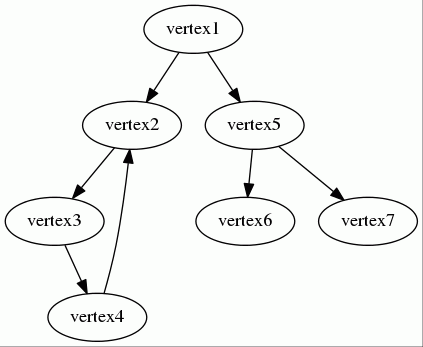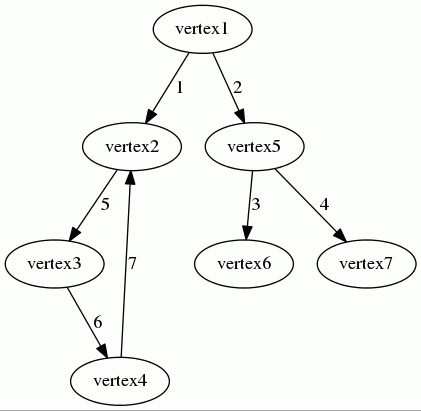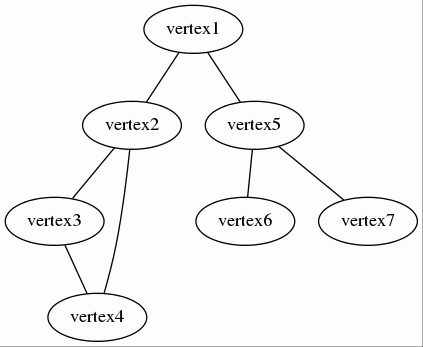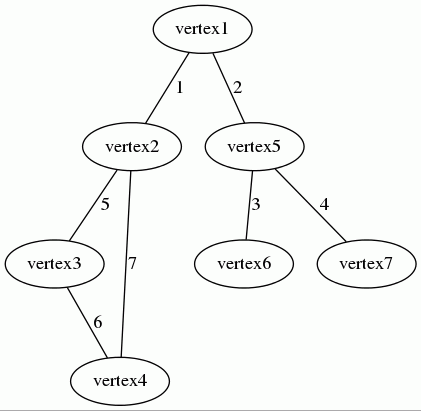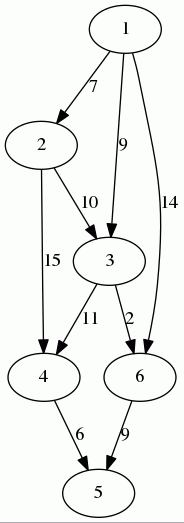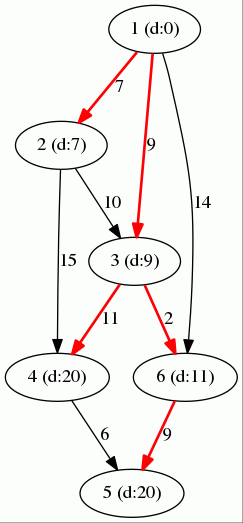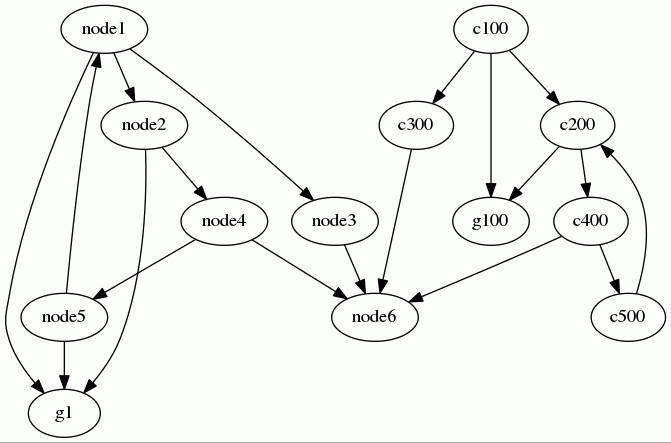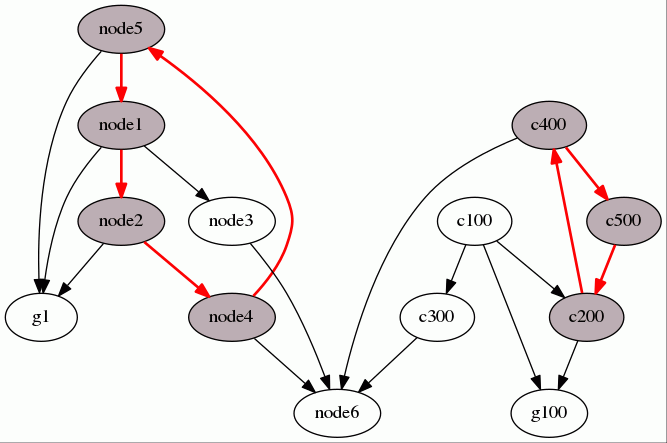dbeurive / graph
本包包含各种图算法的实现
Requires (Dev)
- phpunit/phpunit: >=5.5.0
This package is not auto-updated.
Last update: 2024-09-23 14:29:17 UTC
README
介绍
此存储库包含各种图算法的实现。
许可协议
本代码在以下许可协议下发布
查看文件LICENSE.TXT
安装
从命令行
composer require dbeurive/graph
或,在文件composer.json内
"require": {
"dbeurive/graph": "*"
}
图类型
图可能是
- 有向或无向。
- 加权或无权。
给定的图可能是
图的表示
可以使用多种形式来表示图。例如
- 边列表
- 邻接矩阵
- 邻接表
本文档介绍了表示图的多种方式
此PHP模块使用称为“邻接表”的公理化。
有向图
顶点有后继(和前驱)。
我们可以选择通过后继列表或前驱列表来描述图。
有向无权图
让我们考虑以下有向无权图
关联数组可以表示为以下关联数组
array( 'vertex1' => array('vertex2' => null, 'vertex5' => null), 'vertex5' => array('vertex6' => null, 'vertex7' => null), 'vertex2' => array('vertex3' => null), 'vertex3' => array('vertex4' => null), 'vertex4' => array('vertex2' => null) )
或CSV文件
vertex1 vertex2 vertex5
vertex5 vertex6 vertex7
vertex2 vertex3
vertex3 vertex4
vertex4 vertex2
- 顶点
vertex1有两个后继:vertex2和vertex5。 - 顶点
vertex2有一个后继:vertex3。 - ...
见此示例。
有向加权图
让我们考虑以下有向加权图
关联数组可以表示为以下关联数组
array( 'vertex1' => array('vertex2' => 1, 'vertex5' => 2), 'vertex5' => array('vertex6' => 3, 'vertex7' => 4), 'vertex2' => array('vertex3' => 5), 'vertex3' => array('vertex4' => 6), 'vertex4' => array('vertex2' => 7) )
或CSV文件
vertex1 vertex2:1 vertex5:2
vertex5 vertex6:3 vertex7:4
vertex2 vertex3:5
vertex3 vertex4:6
vertex4 vertex2:7
- 顶点
vertex1有两个后继:vertex2和vertex5。- 从
vertex1到vertex2的边的权重为1。 - 从
vertex1到vertex5的边的权重为2。
- 从
- 顶点
vertex2有一个后继:vertex3。- 从
vertex2到vertex3的边的权重为5。
- 从
- ...
请参阅此示例。
无向图
顶点有邻居。
无向且无权
让我们考虑以下无向无权图
关联数组可以表示为以下关联数组
array( 'vertex1' => array('vertex2' => null, 'vertex5' => null), 'vertex5' => array('vertex6' => null, 'vertex7' => null), 'vertex2' => array('vertex3' => null), 'vertex3' => array('vertex4' => null), 'vertex4' => array('vertex2' => null) );
或通过CV文件
vertex1 vertex2 vertex5
vertex5 vertex6 vertex7
vertex2 vertex3
vertex3 vertex4
vertex4 vertex2
- 顶点
vertex1有两个邻居:vertex2和vertex5。 - 顶点
vertex1有两个邻居:vertex6和vertex7。 - ...
请参阅此示例。
无向且有向
让我们考虑以下无向加权图
关联数组可以表示为以下关联数组
array( 'vertex1' => array('vertex2' => 1, 'vertex5' => 2), 'vertex5' => array('vertex6' => 3, 'vertex7' => 4), 'vertex2' => array('vertex3' => 5), 'vertex3' => array('vertex4' => 6), 'vertex4' => array('vertex2' => 7) );
或通过CSV文件
vertex1 vertex2:1 vertex5:2
vertex5 vertex6:3 vertex7:4
vertex2 vertex3:5
vertex3 vertex4:6
vertex4 vertex2:7
- 顶点
vertex1有两个后继:vertex2和vertex5。- 从
vertex1到vertex2的边的权重为1。 - 从
vertex1到vertex5的边的权重为2。
- 从
- 顶点
vertex2有一个后继:vertex3。- 从
vertex2到vertex3的边的权重为5。
- 从
- ...
请参阅此示例。
图API
介绍
图的API允许以下操作
- 从CSV文件加载图。
- 将图转储到CSV文件。
- 创建图的GraphViz表示。
- "完成"图的表示。
- 对于有向图:从后继者的列表计算前驱者的列表,反之亦然。
而不是详细描述API,我们将展示使用示例。
可以使用phpDocumentor生成详细的API描述。只需转到此包的根目录并执行以下命令:
phpdoc。文档将在doc/api目录内生成。
从CSV文件加载图
使用默认加载器加载CSV
摘要
$graph = new DirectedUnweighted(); // or DirectedWeighted $graph->loadSuccessorsFromCsv($csvSuccessorsPath); $graph->loadPredecessorsFromCsv($csvPredecessorsPath); $graph = new UndirectedUnweighted(); // or UndirectedWeighted $graph->loadNeighboursFromCsv($csvSuccessorsPath);
默认情况下
- 字段由空格分隔。
- 边的权重由冒号字符表示。
- 顶点名称按原样加载。
标准CSV文件的示例
vertex1
vertex2 vertex1 vertex4
vertex5 vertex1
vertex6 vertex5
vertex7 vertex5
vertex3 vertex2
vertex4 vertex3
或
vertex1
vertex2 vertex1:1 vertex4:7
vertex5 vertex1:2
vertex6 vertex5:3
vertex7 vertex5:4
vertex3 vertex2:5
vertex4 vertex3:6
请参阅示例from-csv-directed-unweighted.php。
请参阅示例from-csv-directed-weighted.php。
请参阅示例from-csv-undirected-unweighted.php。
请参阅示例from-csv-undirected-weighted.php。
使用自定义加载器加载CSV
摘要
$graph = new DirectedUnweighted(); // or UndirectedUnweighted $graph->setFieldSeparator(';'); $graph->setVertexUnserializer(function($inVertex) { return strtoupper($inVertex); }); $graph->setLinePreProcessor(function($inLine) { return trim($inLine); }); $graph = new DirectedWeighted(); // or UndirectedWeighted $graph->setFieldSeparator(';'); $graph->setVertexUnserializer(function($inVertex) { return strtoupper($inVertex); }); $graph->setLinePreProcessor(function($inLine) { return trim($inLine); }); $graph->setWeightIndicator('::');
在加载CSV文件时,可以指定非标准属性
- 字段分隔符。默认字段分隔符是空格(" ")。
- 权重指示符(仅适用于加权图)。默认权重指示符是冒号字符(":")。
还可以指定对以下数据的操作
- 顶点名称。
- CSV行(例如,您可以删除前导和尾随空格)。
操作通过"可调用"(参见此说明)指定。
在以下示例中
- 我们更改了字段分隔符(我们使用";"而不是" ")。
- 我们更改了权重指示符(我们使用"::"而不是":")。
- 我们将顶点名称转换为大写。
- 在执行任何其他操作之前,我们删除了每行的前导和尾随空格。
请参阅示例from-csv-directed-unweighted-non-standard.php。
请参阅示例from-csv-directed-weighted-non-standard.php。
将图转储到CSV文件
使用默认转储器转储到CSV
摘要
$graph = new DirectedUnweighted(); // Or DirectedWeighted $graph->setSuccessors($listOfSuccessors); // You can also set the lists of predecessors. $graph->dumpSuccessorsToCsv($csvPath); // You can also dump the lists of predecessors. $graph = new UndirectedUnweighted(); // Or UndirectedWeighted $graph->setNeighbours($listOfNeighbours); $graph->dumpNeighboursToCsv($csvPath);
查看示例 to-csv-directed-unweighted.php。
查看示例 to-csv-directed-weighted.php。
查看示例 to-csv-undirected-unweighted.php。
查看示例 to-csv-undirected-weighted.php。
使用自定义的导出器将数据导出到CSV
摘要
// Directed Weighted $graph = new DirectedWeighted(); $graph->setSuccessors($listOfSuccessors); $graph->calculatePredecessorsFromSuccessors(); $graph->setFieldSeparator(';'); $graph->setVertexSerializer(function($inVertex) { return strtoupper($inVertex); }); $graph->setWeightIndicator('::'); $graph->dumpSuccessorsToCsv($csvPath); $graph->dumpPredecessorsToCsv($csvPath); // Directed Unweighted $graph = new DirectedUnweighted(); $graph->setSuccessors($listOfSuccessors); $graph->calculatePredecessorsFromSuccessors(); $graph->setFieldSeparator(';'); $graph->setVertexSerializer(function($inVertex) { return strtoupper($inVertex); }); $graph->dumpSuccessorsToCsv($csvPath); $graph->dumpPredecessorsToCsv($csvPath); // Undirected Weighted $graph = new UndirectedWeighted(); $graph->setFieldSeparator(';'); $graph->setWeightIndicator('::'); $graph->setVertexSerializer(function ($inVertex) { return strtoupper($inVertex); } ); $graph->setNeighbours($listOfNeighbours); $graph->dumpNeighboursToCsv($csvPath); // Undirected Unweighted $graph = new UndirectedUnweighted(); $graph->setFieldSeparator(';'); $graph->setVertexSerializer(function ($inVertex) { return strtoupper($inVertex); } ); $graph->setNeighbours($listOfNeighbours); $graph->dumpNeighboursToCsv($csvPath);
在导出CSV文件时,可以指定非标准的属性
- 字段分隔符。默认字段分隔符是空格(" ")。
- 权重指示符(仅适用于加权图)。默认权重指示符是冒号字符(":")。
还可以指定对以下数据的操作
- 顶点名称。
操作通过"可调用"(参见此说明)指定。
查看示例 to-csv-directed-unweighted-non-standard.php。
查看示例 to-csv-directed-weighted-non-standard.php。
查看示例 to-csv-undirected-unweighted-non-standard.php。
查看示例 to-csv-undirected-weighted-non-standard.php。
将图导出到其GraphViz表示形式
摘要
$graph = new DirectedUnweighted(); // or DirectedWeighted $graph->setSuccessors($listOfSuccessors); $txt = $graph->dumpSuccessorsToGraphviz(); $graph->calculatePredecessorsFromSuccessors(); $txt = $graph->dumpPredecessorsToGraphviz(); $graph = new UndirectedUnweighted(); // or UndirectedWeighted $graph->setNeighbours($listOfNeighbours); $txt = $graph->dumpNeighboursToGraphviz();
请注意,生成的GraphViz表示形式可高度自定义。方法
dumpSuccessorsToGraphviz、dumpPredecessorsToGraphviz和dumpNeighboursToGraphviz接受参数。这些参数允许您自定义顶点和边的外观。
查看示例 to-graphviz-directed-unweighted.php。
查看示例 to-graphviz-directed-weighted.php。
查看示例 to-graphviz-undirected-unweighted.php。
查看示例 to-graphviz-undirected-weighted.php。
使用算法
"广度优先搜索"算法
请参阅此处的描述。
概要
$vertices = array(); // Define a callback that will be executed for each visited vertex. // * If the function returns true, then the exploration of the graph continues. // * If the function returns false, then the exploration of the graph ends. $callback = function($inVertex) use(&$vertices) { $vertices[] = $inVertex; return true; }; // For directed graphs $graph = new DirectedUnweighted(); // or DirectedWeighted $graph->setSuccessors($successors, true); $graph->calculatePredecessorsFromSuccessors(); $algo = new DirectedBreadthFirstSearch($graph, $callback); $algo->followSuccessors(); $algo->run('e1', $callback); // Start traversing the graph from the vertex 'e1', following the sucessors. $algo->followPredecessors(); $algo->run('e1', $callback); // Start traversing the graph from the vertex 'e1', following the predecessors. // For undirected graphs $graph = new UndirectedUnweighted(); // or UndirectedWeighted $graph->setNeighbours($successors, true); $algorithm = new UndirectedBreadthFirstSearch($graph, $callback); $algorithm->run('e1', $callback); // Start traversing the graph.
请注意,此算法适用于有向和无向图。
请注意,回调函数(
$callback)返回的值决定了方法run()的行为。
- 如果回调函数返回值为true,则方法
run()继续图的遍历。- 如果回调函数返回值为false,则方法
run()停止图的遍历。
查看示例 breadth-first-search-directed.php。
查看示例 breadth-first-search-undirected.php。
"深度优先搜索"算法
请参阅此处的描述。
概要
$vertices = array(); // Define a callback that will be executed for each visited vertex. // * If the function returns true, then the exploration of the graph continues. // * If the function returns false, then the exploration of the graph ends. $callback = function($inVertex) use(&$vertices) { $vertices[] = $inVertex; return true; }; // For directed graphs $graph = new DirectedUnweighted(); // Or DirectedWeighted $graph->setSuccessors($successors, true); $graph->calculatePredecessorsFromSuccessors(); $algo = new DirectedDepthFirstSearch($graph, $callback); $algo->followSuccessors(); $algo->run('e1', $callback); // Start traversing the graph from the vertex 'e1', following the successors. $algo->followPredecessors(); $algo->run('e1', $callback); // Start traversing the graph from the vertex 'e1', following the predecessors.
请注意,此算法适用于有向和无向图。
请注意,回调函数(
$callback)返回的值决定了方法run()的行为。
- 如果回调函数返回值为true,则方法
run()继续图的遍历。- 如果回调函数返回值为false,则方法
run()停止图的遍历。
查看示例 depth-first-search-directed.php。
查看示例 depth-first-search-undirected.php。
迪杰斯特拉算法
请参阅此处的描述。
- 此算法适用于有向和无向图。
- 图必须是带权重的。
概要
// With directed graphs $graph = new DirectedWeighted(); $graph->setSuccessors($successors, true); $algorithm = new DirectedDijkstra($graph); $algorithm->followSuccessors(); $distances = $algorithm->run($vertexName); // Start the algorithm. $txt = $algorithm->dumpToGraphviz(); // For a nice representation of the result. // With undirected graphs $graph = new UndirectedWeighted(); $graph->setNeighbours($neighbours, true); $algorithm = new UndirectedDijkstra($graph); $distances = $algorithm->run($vertexName); $txt = $algorithm->dumpToGraphviz(); // For a nice representation of the result.
查看示例 dijkstra-directed.php。
查看示例 dijkstra-undirected.php。
示意图
给定以下图,让我们找到从顶点 "1" 到所有其他顶点的最短路径。
运行算法后,我们得到
- 顶点 "
1" 和顶点 "3" 之间的最短距离是 9。 - 顶点 "
1" 和顶点 "6" 之间的最短距离是 11。 - 顶点 "
1" 和顶点 "5" 之间的最短距离是 20。 - ...
最短路径用红色打印。
Tarjan 算法
请参阅此处的描述。
- 此算法仅适用于有向图。
- 图可以是加权的,也可以不是。
概要
$graph = new DirectedUnweighted(); // or DirectedWeighted $graph->setSuccessors($successors, true); $algorithm = new DirectedTarjan($graph); $algorithm->followSuccessors(); $scc = $algorithm->run(); $cycles = $algorithm->getCycles(); $txt = $algorithm->dumpToGraphviz(); // For a nice representation of the result.
查看示例 tarjan.php。
示意图
给定以下图,让我们找到所有环
运行算法后,我们得到
请注意,此算法不会返回图内环的列表。它返回的是强连通分量的列表。然而,环检测是此算法的应用之一。在这里,我们选择展示
getCycles()方法的结果。

